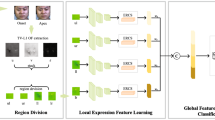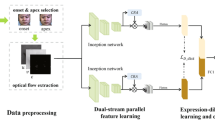Abstract
Micro-expression has emerged to be a feasible strategy in affective estimation due to its great reliability in emotion detection. Recent years have witnessed that deep learning methods were successfully applied to the micro-expression recognition field. In visual data, micro-expression only exists in regions such as eyebrows and mouth, etc, which leads to its imbalanced distribution. Therefore, it’s difficult for networks to distinguish the above micro-expression description with weak intensity when extracting feature maps. To tackle such issues, we propose a novel lightweight attention model, LAM, to improve the network recognition performance. LAM is enabled to calculate the correlation between the feature maps (channel dimension) and the correlation within the feature maps (spatial dimension), thus helping the network to focus on micro-expression information. Additionally, cooperated with residual block at various scales in Resnet, LAM can adaptively compute and update the feature maps in each network layer. Technically, coping with small datasets, we build LAM without adding obvious parameters, while a straightforward but efficient strategy that transfer facial expression knowledge is utilized together. Extensive experimental evaluations on two benchmarks (CASME II and SAMM) and post-hoc feature visualizations demonstrate the effectiveness of our proposed network with LAM.















Similar content being viewed by others
Data availability
The datasets (CASME II and SAMM) used in this work are publicly available.
References
Bhall RK, Sharma V (2015) A review: detection and analysis of facial micro-expression. Int J Educ Sci Res Rev (IJESRR) 2(1)
Porter S, Brinke LT (2008) Reading between the lies: identifying concealed and falsified emotions in universal facial expressions. Psychol Sci 19(5):508–514
Russell TA, Chu E, Phillips ML (2006) A pilot study to investigate the effectiveness of emotion recognition remediation in schizophrenia using the micro-expression training tool. Br J Clin Psychol 45:579–583
Weinberger S (2010) Airport security: intent to deceive. Nature 412–415
Ekman P (2007) Emotions revealed: recognizing faces and feelings to improve communication and emotional Life. Macmillan
Ojala T, Pietikainen M, Harwood D (1994) Performance evaluation of texture measures with classification based on Kullback discrimination of distributions. Proceedings of the 12th international conference on pattern pecognition, pp 582–585
Sun D, Roth S, Black MJ (2014) A quantitative analysis of current practices in optical flow estimation and the principles behind them. Int J Comput Vis 106(2):115–137
Jakkula V (2006) Tutorial on support vector machine (svm). School of EECS, Washington State University 37(2.5):3
Wang SJ, Chen HL, Yan WJ et al (2014) Face recognition and micro-expression recognition based on discriminant tensor subspace analysis plus extreme learning machine. Neural Process Lett 39(1):25–43
Pfister T, Li X B, Zhao GY et al (2011) Recognising spontaneous facial micro-expressions[C]. In Proceedings of the 2011 IEEE international conference on computer vision. Barcelona, Spain, pp 1449–1456
Wei J, Lu G, Yan J et al (2022) Micro-expression recognition using local binary pattern from five intersecting planes[J]. Multimed Tools Appl 5(9):1–26
Wang YD, See J, Phan PCW et al (2014) LBP with six intersection points: reducing redundant information in LBP-TOP for micro-expression recognition[C]. In Proceedings of the 12th Asian conference on computer vision. Singapore, Singapore, pp 21–23
Huang XH, Wang SJ, Zhao GY et al (2015) Facial micro-expression recognition using spatiotemporal local binary pattern with integral projection[C]. In Proceedings of the 2015 IEEE international conference on Computer vision workshops. Santiago, Chile, pp 1–9
Huang X, Wang SJ, Liu X et al (2019) Discriminative spatiotemporal local binary pattern with revisited integral projection for spontaneous facial micro-expression recognition[J]. IEEE Trans Affect Comput 10(1):32–47
Wei J, Lu G, Yan J (2021) A comparative study on movement feature in different directions for micro-expression recognition[J]. Neurocomputing 449(1):159–171
Lucas BD, Kanade T (1981) An iterative image registration technique with an application to stereo vision[C]. In Proceedings of the 7th international joint conference on artificial intelligence, vol 2. Vancouver, Canada, pp 674–679
Xu F, Zhang J, Wang JZ (2017) Micro-expression identification and categorization using a facial dynamics map[J]. IEEE Trans Affect Comput 8(2):254–267
Liu YJ, Zhang JK, Yan WJ et al (2015) A main directional mean optical flow feature for spontaneous micro-expression recognition[J]. IEEE Trans Affect Comput 7(4):299–310
Xia B, Wang W, Wang S et al (2020) Learning from macro-expression: a micro-expression recognition framework[C]. In Proceedings of the 28th ACM international conference on multimedia. Montreal, Canada, pp 2936–2944
Wang C, Peng M, Bi T et al (2020) Micro-attention for micro-expression recognition[J]. Neurocomputing 410(7):354–362
Tang H, Chai L, Lu W (2022) Transferring dual stochastic graph convolutional network for facial micro-expression recognition[J]. Image Video Process 34(1):2–6
Zhang J, Yan B, Du X et al (2022) Motion magnification multi-feature relation network for facial microexpression recognition[J]. Complex Intell Syst 2(4):1–14
Khor HQ, See J, Phan RCW et al (2018) Enriched long-term recurrent convolutional network for facial micro-expression recognition[C]. In Proceedings of the 13th IEEE international conference on automatic face and gesture recognition. Xi’an, China, pp 667–674
Pérez JS, Meinhardt LE, Facciolo G (2013) TV-L1 optical flow estimation[J]. Image Processing on Line 1(3):137–150
Itti L, Koch C (2001) Computational modelling of visual attention. Nat Rev Neurosci 2(3):194
Liang Z, He J, Sun Y (2020) A three-dimensional convolution neural network evolution method for automatic recognition of micro expression. Comput Sci 47(8):227–232
Liu Y, Du H, Zheng L et al (2019) A neural micro-expression recognizer. 2019 14th IEEE international conference on automatic face & gesture recognition, pp 23–30
Deng J, Dong W, Socher R, Li L-J, Li K, Li F-F (2009) Imagenet: a large-scale hierarchical image database. In Proceedings of the 2009 IEEE conference on computer vision and pattern recognition. Miami, Florida, USA, pp 248–255
Lucey P, Cohn JF, Kanade T, Saragih J, Ambadar Z, Matthews I (2010) The extended cohn-kanade dataset (ck+): a complete dataset for action unit and emotion-specified expression. In Proceedings of the 2010 IEEE computer vision and pattern recognition workshops, San Francisco, CA, USA, pp 94–101
Lyons, Michael, Akamatsu S, Kamachi M, Gyoba J (1998) Coding facial expressions with gabor wavelets. In Proceedings of the 3rd international conference on automatic face and gesture recognition. Nara, Japan, pp 200–205
Yan WJ, Li X, Wang SJ, Zhao G, Liu YJ, Chen YH, Fu X (2014) CASME II: an improved spontaneous micro-expression database and the baseline evaluation. PloS one 9(1)
Davison AK, Lansley C, Costen N, Tan K, Yap MH (2018) Samm: a spontaneous micro-facial movement dataset. IEEE Trans Affective Comput 9(1):116–129
Cootes TF, Edwards GJ, Taylor CJ (2001) Active appearance models. IEEE Trans Pattern Anal Mach Intell 6:681–685
Oh TH, Jaroensri R, Kim C, Elgharib M, Durand FE, Freeman WT, Matus-ik W (2018) Learning-based video motion magnification. Proceedings of the European conference on computer Vision, pp 633–648
Merghani W, Davison A, Yap M (2018) Facial micro-expressions grand challenge 2018: evaluating spatiotemporal features for classification of objective classes. In Proceedings of the 13th International conference on automatic face & gesture recognition. Xi’an, China, pp 662–666
Khor HQ, See J, Liong T et al (2019) Dual-stream shallow networks for facial micro-expression recognition[C]. In Proceedings of the 2019 IEEE international conference on image processing. Taipei, Taiwan, pp 36–40
Lei L, Chen T, Li SG et al (2021) Micro-expression recognition based on facial graph representation learning and facial action unit fusion[C]. In Proceedings of the 2021 IEEE/CVF conference on computer vision and pattern recognition workshops. Tennessee, USA, pp 76–79
Acknowledgements
This work was supported in part by the National Natural Science Foundation of China under Grants 71774159 and 61977061, the Fund of State Key Laboratory of NBC Protection for Civilian under Grants SKLNBC2020-23. Dr. Dashuai Hao and Dr. Chen Zhang contribute equally to this work.
Author information
Authors and Affiliations
Corresponding authors
Additional information
Publisher's Note
Springer Nature remains neutral with regard to jurisdictional claims in published maps and institutional affiliations.
Rights and permissions
Springer Nature or its licensor (e.g. a society or other partner) holds exclusive rights to this article under a publishing agreement with the author(s) or other rightsholder(s); author self-archiving of the accepted manuscript version of this article is solely governed by the terms of such publishing agreement and applicable law.
About this article
Cite this article
Hao, D., Zhu, M., Zhang, C. et al. A lightweight attention-based network for micro-expression recognition. Multimed Tools Appl 83, 29239–29260 (2024). https://doi.org/10.1007/s11042-023-16616-y
Received:
Revised:
Accepted:
Published:
Issue Date:
DOI: https://doi.org/10.1007/s11042-023-16616-y




